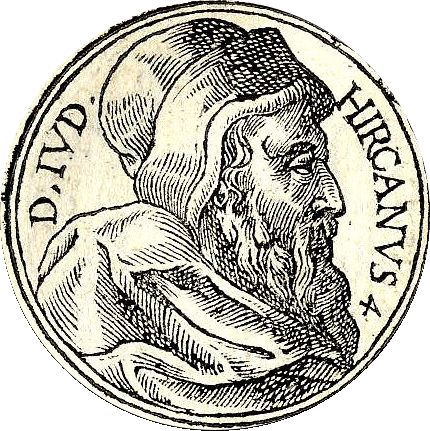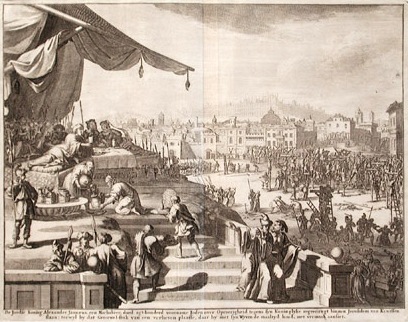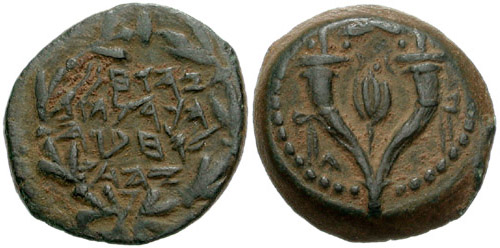|
Sadducees
The Sadducees (; he, צְדוּקִים, Ṣədūqīm) were a socio- religious sect of Jewish people who were active in Judea during the Second Temple period, from the second century BCE through the destruction of the Second Temple , Temple in 70 CE. The Sadducees are often compared to other contemporaneous sects, including the Pharisees and the Essenes. Josephus, writing at the end of the 1st century CE, associates the sect with the upper social and economic echelon of Judean society. As a whole, they fulfilled various political, social, and religious roles, including maintaining the Temple in Jerusalem. The group became extinct some time after the destruction of Herod's Temple in Jerusalem in 70 CE. Etymology According to Abraham Geiger, the Sadducee sect of Judaism derived their name (Greek: Saddoukaioi; Hebrew: ṣāddūqim) from that of Zadok, the first High Priest of Israel, High Priest of ancient Israel in the time of Solomon to serve in the First Temple; ... [...More Info...] [...Related Items...] OR: [Wikipedia] [Google] [Baidu] |
Pharisees
The Pharisees (; he, פְּרוּשִׁים, Pərūšīm) were a Jewish social movement and a school of thought in the Levant during the time of Second Temple Judaism. After the destruction of the Second Temple in 70 CE, Pharisaic beliefs became the foundational, liturgical, and ritualistic basis for Rabbinic Judaism. Conflicts between Pharisees and Sadducees took place in the context of much broader and longstanding social and religious conflicts among Jews, made worse by the Roman conquest. One conflict was cultural, between those who favored Hellenization (the Sadducees) and those who resisted it (the Pharisees). Another was juridical-religious, between those who emphasized the importance of the Temple with its rites and services, and those who emphasized the importance of other Mosaic Laws. A specifically religious point of conflict involved different interpretations of the Torah and how to apply it to current Jewish life, with Sadducees recognizing only the Written Tor ... [...More Info...] [...Related Items...] OR: [Wikipedia] [Google] [Baidu] |
Sons Of Zadok
The Sons of Zadok ( he, בְּנֵי צָדוֹק ''bǝnê Ṣādōq'') are a family of priests, kohens, descended from Zadok, the first high priest in Solomon's Temple. The sons of Zadok are mentioned three times in the Hebrew Bible, as part of the Third Temple prophecy in the final chapters of the Book of Ezekiel, and are a theme in Jewish and Christian interpretation of these chapters. Hebrew Bible The Aaronic priesthood in the Tanakh The Tanakh records how prior to the death of Aaron at Hor HaHar, he was accompanied by his brother Moses, as well as his (Aaron's) elder son Eleazar and younger son Ithamar. Upon entry to the cave where Aaron died, he witnessed as his brother Moses dressed his elder son Eleazer with the clothes of the high priesthood, as initiation to high priesthood. Jewish commentaries on the Bible express that this initiation ceremony served as the catalyst for the stipulation that all future candidates of high priesthood be patrilineal descendants of ... [...More Info...] [...Related Items...] OR: [Wikipedia] [Google] [Baidu] |
Boethusians
The Boethusians () were a Jewish sect closely related to, if not a development of, the Sadducees. Origins according to the Talmud The post-Talmudic work ''Avot of Rabbi Natan'' gives the following origin of the schism between the Pharisees and Sadducees/Boethusians: Antigonus of Sokho having taught the maxim, "Be not like the servants who serve their masters for the sake of the wages, but be rather like those who serve without thought of receiving wages", his two pupils, Zadok and Boethus, repeated this maxim to their pupils. In the course of time, either the two teachers or their pupils understood this to express the belief that there was neither an afterlife nor a resurrection of the dead and founded the sects of the Sadducees and the Boethusians. They lived in luxurious splendor; using silver and golden vessels all their lives, not because they were haughty, but because (as they claimed) the Pharisees led a hard life on earth and yet would have nothing to show for it in the wor ... [...More Info...] [...Related Items...] OR: [Wikipedia] [Google] [Baidu] |
Second Temple Period
The Second Temple period in Jewish history lasted approximately 600 years (516 BCE - 70 CE), during which the Second Temple existed. It started with the return to Zion and the construction of the Second Temple, while it ended with the First Jewish–Roman War and the Siege of Jerusalem (70), destruction of Jerusalem in 70 CE. In 587/6 BCE, the Kingdom of Judah was conquered by the Neo-Babylonian Empire. The Judeans lost their independence and monarchy, and Siege of Jerusalem (587 BC), their holy city was destroyed. Part of the Judean population Babylonian captivity, was exiled to Babylon; it was eventually Return to Zion, allowed to return following Edict of Cyrus, a proclamation by the Persian king Cyrus the Great that was issued after the fall of Babylon to the Achaemenid Empire. Under Yehud (Persian province), Persian provincial governance ( 539 – 332 BCE), the returned Jewish population in Judah was allowed to self-govern and rebuild the Temple in Jerusalem. In 332 BCE, Jud ... [...More Info...] [...Related Items...] OR: [Wikipedia] [Google] [Baidu] |
Essenes
The Essenes (; Hebrew: , ''Isiyim''; Greek: Ἐσσηνοί, Ἐσσαῖοι, or Ὀσσαῖοι, ''Essenoi, Essaioi, Ossaioi'') were a mystic Jewish sect during the Second Temple period that flourished from the 2nd century BCE to the 1st century CE. The Jewish historian Josephus records that Essenes existed in large numbers, thousands lived throughout Roman Judaea. They were fewer in number than the Pharisees and the Sadducees, the other two major sects at the time. The Essenes lived in various cities but congregated in communal life dedicated to voluntary poverty, daily immersion, and asceticism (their priestly class practiced celibacy). Most scholars claim they seceded from the Zadokite priests. The Essenes have gained fame in modern times as a result of the discovery of an extensive group of religious documents known as the Dead Sea Scrolls, which are commonly believed to be the Essenes' library. These documents preserve multiple copies of parts of the Hebrew Bible unt ... [...More Info...] [...Related Items...] OR: [Wikipedia] [Google] [Baidu] |
Zadok
Zadok (or Zadok HaKohen, also spelled Ṣadok, Ṣadoc, Zadoq, Tzadok, or Tsadoq; he, צָדוֹק הַכֹּהֵן, meaning "Righteous, Justified") was a Kohen (priest), biblically recorded to be a descendant from Eleazar the son of Aaron (). He was the High Priest of Israel during the reigns of David and Solomon (). He aided King David during the revolt of his son Absalom, was subsequently instrumental in bringing Solomon to the throne and officiated at Solomon's coronation. After Solomon's building of the First Temple in Jerusalem, Zadok was the first High Priest to serve there (). The prophet Ezekiel extols in the book attributed to him the sons of Zadok as staunch opponents of paganism during the era of pagan worship and indicates their birthright to unique duties and privileges in the future temple (). Hebrew Bible The Tanakh (Hebrew Bible) states that Zadok was a patrilineal descendant of Eleazar the son of Aaron the high priest. ( 2 Samuel 8:17; 1 Chronicles 2 ... [...More Info...] [...Related Items...] OR: [Wikipedia] [Google] [Baidu] |
Siege Of Jerusalem (70)
The siege of Jerusalem of 70 CE was the decisive event of the First Jewish–Roman War (66–73 CE), in which the Roman army led by future emperor Titus besieged Jerusalem, the center of Jewish rebel resistance in the Roman province of Judaea. Following a brutal five-month siege, the Romans destroyed the city and the Second Jewish Temple. In April 70 CE, three days before Passover, the Roman army started besieging Jerusalem. The city had been taken over by several rebel factions following a period of massive unrest and the collapse of a short-lived provisional government. Within three weeks, the Roman army broke the first two walls of the city, but a stubborn rebel standoff prevented them from penetrating the thickest and third wall. According to Josephus, a contemporary historian and the main source for the war, the city was ravaged by murder, famine and cannibalism. On Tisha B'Av, 70 CE (August 30), Roman forces finally overwhelmed the defenders and set fire to the ... [...More Info...] [...Related Items...] OR: [Wikipedia] [Google] [Baidu] |
Aristobulus II
Aristobulus II (, grc, Ἀριστόβουλος ''Aristóboulos'') was the Jewish High Priest and King of Judea, 66 BCE to 63 BCE, from the Hasmonean dynasty. Family Aristobulus was the younger son of Alexander Jannaeus, King and High Priest, and Salome Alexandra. After the death of Alexander in 76 BCE, his widow succeeded to the rule of Judea and installed her elder son Hyrcanus II as High Priest in 73 BCE. When Salome died in 67 BCE, Hyrcanus succeeded to the kingship as well. Aristobulus shared his late father's views on religion and politics. He entertained designs upon the throne, even during the life of his mother. He courted the nobles and military party by constituting himself the patron of the Sadducees and bringing their cause before the queen. The many fortresses which the queen placed at the disposal of the Sadducees, ostensibly for their defense against the Pharisees, constituted in reality one of the preparatory moves of Aristobulus for the usurpation of the ... [...More Info...] [...Related Items...] OR: [Wikipedia] [Google] [Baidu] |
Antigonus Of Sokho
Antigonus of Sokho ( he, אנטיגנוס איש סוכו) was the first scholar of whom Pharisee tradition has preserved not only the name but also an important theological doctrine. He flourished about the first half of the third century BCE. According to the Mishnah, he was the disciple of Simon the Just ( he, שמעון הצדיק). Antigonus is the first noted Jew to have a Greek language, Greek name, a fact commonly discussed by scholars regarding the extent of Hellenic influence on Judaism following the conquest of Judaea by Alexander the Great. A street in the Katamon, Katamonim neighborhood of Jerusalem is named after him. Sadducees and Boethusians Traditional Jewish sources connect Antigonus with the origin of the Sadducees and Boethusians. These sources argue that the Sadducee group originated ''in tandem'' with the Boethusians, Boethusian group during the Second Temple period, with their founders, Zadok and Boethus, both being individual students of Antigonus of ... [...More Info...] [...Related Items...] OR: [Wikipedia] [Google] [Baidu] |
Alexander Jannaeus
Alexander Jannaeus ( grc-gre, Ἀλέξανδρος Ἰανναῖος ; he, ''Yannaʾy''; born Jonathan ) was the second king of the Hasmonean dynasty, who ruled over an expanding kingdom of Judea from 103 to 76 BCE. A son of John Hyrcanus, he inherited the throne from his brother Aristobulus I, and married his brother's widow, Queen Salome Alexandra. From his conquests to expand the kingdom to a bloody civil war, Alexander's reign has been generalised as cruel and oppressive with never-ending conflict. The major historical sources of Alexander's life are Josephus's ''Antiquities of the Jews'' and '' The Jewish War''. The kingdom of Alexander Jannaeus was the largest and strongest known Jewish State outside of biblical sources, having conquered most of Palestine's Mediterranean coastline and regions surrounding the Jordan River. Alexander also had many of his subjects killed for their disapproval of his handling of state affairs. Due to his territorial expansion and inte ... [...More Info...] [...Related Items...] OR: [Wikipedia] [Google] [Baidu] |
John Hyrcanus
John Hyrcanus (; ''Yōḥānān Hurqanōs''; grc, Ἰωάννης Ὑρκανός, Iōánnēs Hurkanós) was a Hasmonean ( Maccabean) leader and Jewish high priest of the 2nd century BCE (born 164 BCE, reigned from 134 BCE until his death in 104 BCE). In rabbinic literature he is often referred to as ''Yoḥanan Cohen Gadol'' (), "John the High Priest". Name Josephus explains in ''The Jewish War'' that John was also known as "Hyrcanus", but does not explain the reason behind this name. The only other primary source, the Books of the Maccabees, never used this name with respect to John. The single occurrence of the name ''Hyrcanus'' in 2 Maccabees 3:11 refers to a man to whom some of the money in the Temple belonged during the c. 178 BCE visit of Heliodorus. The reason for the name is disputed amongst biblical scholars, with a variety of reasons proposed: * Familial origin in the region of Hyrcania on the Caspian Sea * A Greek regnal name, which would have represented clos ... [...More Info...] [...Related Items...] OR: [Wikipedia] [Google] [Baidu] |
Second Temple
The Second Temple (, , ), later known as Herod's Temple, was the reconstructed Temple in Jerusalem between and 70 CE. It replaced Solomon's Temple, which is presumed to have been built at the same location before its destruction by the Neo-Babylonian Empire during the Babylonian siege of Jerusalem in . Construction on the Second Temple began some time after the Neo-Babylonian Empire was conquered by the Achaemenid Persian Empire; it followed a proclamation by Persian king Cyrus the Great (see Edict of Cyrus) that ended the Babylonian captivity and initiated the return to Zion. In Jewish history, the Second Temple's completion in Persian Judah marks the beginning of the Second Temple period. According to the Bible, the Second Temple was originally a relatively modest structure built by Jews who had returned from exile in Babylon under the authority of Persian-appointed governor Zerubbabel, the grandson of penultimate Judahite king Jeconiah. However, during the reign of Herod t ... [...More Info...] [...Related Items...] OR: [Wikipedia] [Google] [Baidu] |


.jpg)




